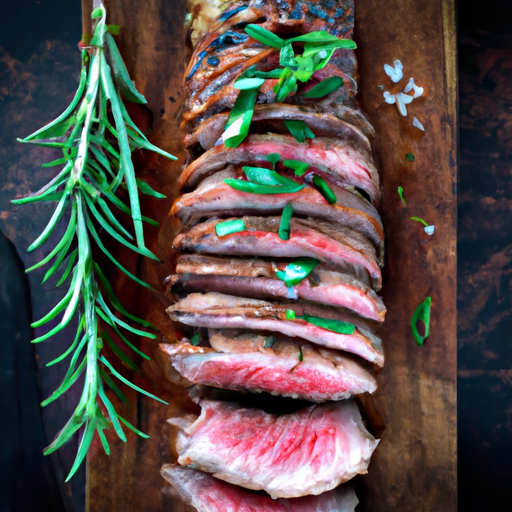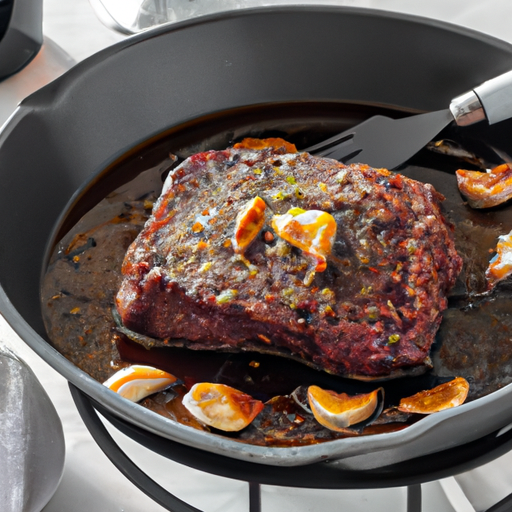Imagine hosting a dinner party and impressing your guests with a mouthwatering beef tenderloin that is perfectly cooked every time. With “The Perfectly Cooked Beef Tenderloin Recipe,” you can now become a master chef in your own kitchen. This recipe provides you with precise cooking times for beef tenderloin, ensuring a juicy and tender result every single time. Say goodbye to overcooked or undercooked meat and say hello to a perfectly cooked beef tenderloin that will leave your guests asking for seconds.

Choosing the Beef Tenderloin
Selecting the Cut of Beef
When it comes to choosing the beef tenderloin, there are a few key things to consider. First and foremost, make sure to select a high-quality cut of beef. Look for a tenderloin that has a good amount of marbling, as this will ensure a juicy and flavorful result. You can also choose between a whole tenderloin or individual steaks, depending on your preference and the number of people you’ll be serving.
Considering the Size and Weight
The size and weight of the beef tenderloin will also play a role in the cooking process. If you’re serving a small gathering, a smaller tenderloin will suffice, but if you’re hosting a larger crowd, you may want to opt for a larger cut. Keep in mind that larger tenderloins will take longer to cook, so be sure to plan accordingly.
Preparing the Beef Tenderloin
Trimming the Tenderloin
Before cooking the beef tenderloin, it’s important to trim off any excess fat or silver skin. This will not only improve the appearance of the final dish but also ensure that the meat cooks evenly. Use a sharp knife and carefully remove any unwanted fat or connective tissue. Be sure to keep the meat intact and avoid removing too much of the valuable meat.
Tying the Tenderloin
Tying the beef tenderloin is an important step that helps maintain its shape during the cooking process. Butchers twine or kitchen string can be used to tie the meat together at regular intervals. This will ensure that the tenderloin retains its cylindrical shape and cooks evenly. Additionally, tying the tenderloin will help it maintain its juiciness and tenderness.
Seasoning the Tenderloin
Seasoning the beef tenderloin is essential for enhancing its natural flavors. Before cooking, generously season the meat with salt and pepper. You can also add additional spices or herbs of your choice to elevate the taste. The seasoning will create a delicious crust on the exterior of the tenderloin while allowing the flavors to penetrate the meat during cooking.
Cooking Methods for Beef Tenderloin
Roasting
Roasting is a popular cooking method for beef tenderloin, as it allows for even heat distribution and the development of a mouthwatering crust. Preheat your oven to the desired temperature and place the seasoned and tied tenderloin on a roasting rack. Cook until it reaches your desired level of doneness, remembering to periodically baste it with the cooking juices for added flavor.
Grilling
Grilling beef tenderloin adds a smoky, charred flavor that many people adore. Start by preheating your grill to medium-high heat. Place the seasoned and tied tenderloin directly on the grill grates and cook it for a few minutes on each side, depending on your preferred level of doneness. Keep a close eye on the tenderloin to avoid overcooking and ensure even searing.
Pan-searing
Pan-searing is a quick and easy cooking method that still delivers great results. Heat a skillet on high heat and add a small amount of oil or butter. When the skillet is hot, carefully place the seasoned tenderloin in the pan. Sear it on all sides until a golden brown crust forms. Once seared, transfer the tenderloin to the oven to finish cooking, or reduce the heat and continue cooking in the skillet, depending on your preference.

Marinating and Resting the Beef Tenderloin
Marinating the Tenderloin
Marinating the beef tenderloin can add flavor and moisture to the meat. Choose a marinade that complements the natural flavors of beef, such as a combination of soy sauce, garlic, and herbs. Place the seasoned and tied tenderloin in a resealable bag, pour the marinade over it, and refrigerate for several hours or overnight. Make sure to remove the tenderloin from the marinade and pat dry before cooking.
Allowing the Tenderloin to Rest
Resting the cooked beef tenderloin is a crucial step in achieving a tender and juicy result. After cooking, remove the tenderloin from the heat source and tent it loosely with aluminum foil. Let it rest for 10 to 15 minutes to allow the juices to redistribute throughout the meat. This resting period allows the meat to relax, resulting in a more succulent and flavorful eating experience.
Determining the Doneness of Beef Tenderloin
Using a Meat Thermometer
Investing in a good meat thermometer is the key to perfectly cooked beef tenderloin. Insert the thermometer probe into the thickest part of the meat, making sure not to touch any bone. The internal temperature will indicate the degree of doneness. For medium-rare, aim for an internal temperature of around 135°F (57°C), while medium should reach 145°F (63°C).
Checking the Internal Temperature
If you prefer not to use a meat thermometer, you can resort to a visual test to determine the doneness of your beef tenderloin. Use your thumb and fingers to compare the firmness of the meat to different parts of your hand. The base of your thumb represents rare, the area near the thumb joint indicates medium-rare, the middle of the thumb represents medium, and the area near the fingertips is well-done.
Serving Suggestions for Beef Tenderloin
Choosing the Right Accompaniments
When it comes to serving beef tenderloin, there are countless delicious accompaniments to choose from. Classic options include roasted potatoes, creamy mashed potatoes, steamed vegetables, or a fresh salad. You can also elevate your dish with a flavorful sauce like a classic red wine reduction or a tangy horseradish cream. The accompaniments can complement the tenderloin’s rich flavors and create a well-rounded meal.
Slicing and Plating the Tenderloin
To showcase the beautiful texture and presentation of the beef tenderloin, it’s important to slice and plate it properly. Use a sharp knife to carve the tenderloin into even slices, about half an inch thick. Fan out the slices on a serving platter or individual plates for an elegant presentation. Garnish with fresh herbs or a sprinkle of sea salt to add a finishing touch to your masterpiece.
Tips and Tricks for Perfectly Cooked Beef Tenderloin
Letting the Meat Come to Room Temperature
Before cooking, it’s advisable to let the beef tenderloin come to room temperature. This allows for more even cooking throughout the meat. Simply remove the tenderloin from the refrigerator and let it sit at room temperature for about 30 minutes. This step ensures that the heat penetrates the meat evenly, resulting in a perfectly cooked and tender tenderloin.
Using a Coating or Crust
One way to take your beef tenderloin to the next level is by adding a coating or crust. This can be achieved by rolling the seasoned tenderloin in crushed peppercorns, breadcrumbs, or a mixture of herbs. The coating not only enhances the flavors but also creates an attractive texture that adds visual appeal to the dish. Be creative and experiment with different coatings to find your favorite combination.
Basting the Tenderloin
Basting the beef tenderloin during the cooking process adds moisture and flavor. This technique involves spooning or brushing the cooking juices or marinade over the meat at regular intervals. Basting keeps the tenderloin moist and prevents it from drying out, resulting in a juicier and more succulent final product. It also infuses the meat with additional flavors, enhancing its overall taste.
Common Mistakes to Avoid
Overcooking the Tenderloin
One common mistake when cooking beef tenderloin is overcooking it. Due to its lean nature, the meat can become dry and tough when cooked beyond the recommended internal temperature. It’s important to monitor the cooking process closely and follow the suggested cooking times and temperatures. Remember that the tenderloin will continue to cook slightly as it rests, so take it out of the heat source just before reaching the desired doneness.
Cutting into the Tenderloin Too Soon
Allowing the beef tenderloin to rest after cooking is crucial, as it allows the juices to redistribute and the meat to reach its optimal tenderness. Resist the temptation to cut into the tenderloin immediately after taking it out of the oven or grill. Give it the recommended resting time of 10 to 15 minutes, and you’ll be rewarded with a succulent and delicious final result.
Storage and Reheating of Cooked Beef Tenderloin
Refrigerating Leftovers
If you have any leftover cooked beef tenderloin, it’s important to store it properly to maintain its quality. Allow the meat to cool to room temperature, then wrap it tightly in plastic wrap or place it in an airtight container. Store it in the refrigerator for up to three to four days. When reheating, be careful not to overcook the tenderloin, as it may become dry. Gentle reheating methods like low heat in the oven or a quick sear in a hot pan work best.
Reheating the Tenderloin Safely
When reheating the cooked beef tenderloin, it’s important to do so safely to prevent any bacterial growth. Before heating, remove the tenderloin from the refrigerator and let it come to room temperature. This will ensure even reheating. When using the oven, preheat it to a low temperature and cover the tenderloin with foil to prevent further drying. Alternatively, a quick sear in a hot pan will warm the meat without sacrificing its moisture.
Final Thoughts
Cooking a beef tenderloin is a rewarding experience that results in a delectable and impressive dish. By selecting the right cut, preparing it properly, and using the appropriate cooking methods, you can achieve a perfectly cooked beef tenderloin every time. Remember to take into account the desired doneness, choose the suitable accompaniments, and follow the tips and tricks to avoid common mistakes. With a little practice and attention to detail, you’ll become a master of cooking beef tenderloin and delight your family and friends with a phenomenal meal. Enjoy the process, savor the flavors, and bon appétit!
